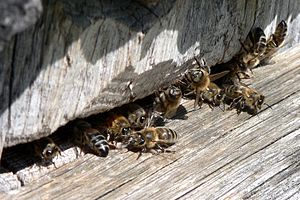Beekeeping is one of the oldest forms of food production. Some of the earliest evidence of beekeeping is from rock painting, dating to around 13,000 BC. It was particularly well developed in Egypt and was discussed by the Roman writers Virgil, Gaius Julius Hyginus, Varro, and Columella. A pioneering beekeeping popularizer in the 19th century United States was Amos Root.

Beekeeping was traditionally practiced for the bees' honey harvest, although nowadays crop pollination service can often provide a greater part of a commercial beekeeper's income. Other hive products are pollen, royal jelly, and propolis, which are also used for nutritional and medicinal purposes, and wax which is used in candlemaking, cosmetics, wood polish, and for modelling. The modern use of hive products has changed little since ancient times.
Western honeybees are not native to the Americas. American, Australian, and New Zealand colonists imported honeybees from Europe, partly for honey and partly for their usefulness as pollinators. The first honeybee species imported were likely European dark bees. Later italian bees, carniolan honeybees and caucasian bees were added.
Western honeybees were also brought to the Primorsky Krai in Russia by Ukrainian settlers around 1850s. These Russian honey bees that are similar to the Carniolan bee were imported into the U.S. in 1990. The Russian honeybee has shown to be more resistant to the bee parasites Varroa destructor and Acarapis woodi.
Before the 1980s, most U.S. hobby beekeepers were farmers or relatives of a farmer, lived in rural areas, and kept bees with techniques passed down for generations. The arrival of tracheal mites in the 1980s and varroa mites and small hive beetles in the 1990s led to the discontinuation of the practice by most of these beekeepers as their bees could not survive among these new parasites.
In Asia, other species of Apis exist which are used by local beekeepers for honey and beeswax. Non-Apis species of honeybees, known collectively as stingless bees, have also been kept from antiquity in Australia and Central America, although these traditions are dying, and the trigonine and meliponine species used are endangered.
Source: wikipedia
No comments:
Post a Comment